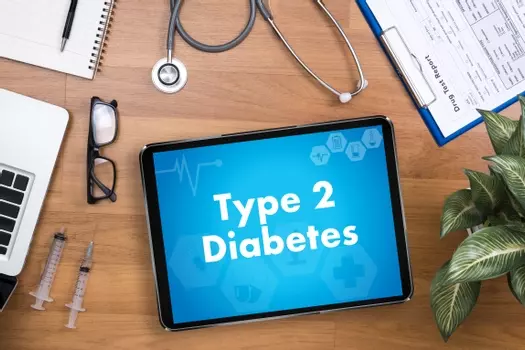What is Type 2 Diabetes?
Authors John Gedney and Pamela Myles-Hooton explore the differences between type 1 and type 2 diabetes in this edited excerpt from their book Living Well with Type 2 Diabetes.
Diabetes is short for diabetes mellitus (DM) – a mixture of Greek and Latin words. Diabetes means ‘syphon’ – the movement of fluid or water – because a classic diabetes symptom is peeing a lot. Mellitus means ‘honeyed’ or ‘sweet’ – referring to the characteristic sweetness of the urine in diabetes. In ancient times, physicians really would diagnose diabetes by tasting their patients’ urine (no dipsticks!). To have too much glucose in the urine, a person has too much glucose in the bloodstream, which then spills over into the urine when blood is filtered by the kidneys. So behind some of the typical symptoms of diabetes is an abnormally high level of glucose in the bloodstream – hyperglycaemia is the medical term.
What actually is type 2 diabetes (T2D)?
The two most common reasons for persisting hyperglycaemia are type 1 diabetes (T1D) and T2D. In spite of the hyperglycaemia which gives each its name they have less in common than you might imagine!
T1D and T2D are different and separate conditions. The legacy of calling all instances of raised blood glucose diabetes is that we tend to see them as more alike than they really are. T1D and T2D don’t have the same cause, or behave in the same way, and outcomes – though similar – are not the same. They really are different diseases, which happen to overlap because of hyperglycaemia.
A common question is, ‘I have type 2 diabetes, but am now on insulin – does this mean I now have type 1 diabetes?’ No! T2D is a different disease, whether treated with insulin or not. Using insulin to lower blood glucose says nothing about the underlying nature of the condition. Everyone with T1D uses insulin because they need it to stay alive; insulin is lost quite quickly and permanently – injections replace the missing natural insulin. Until the late stages of the disease, lack of insulin is not the problem in T2D, which develops against a backdrop of higher than usual insulin levels. But although insulin is present, the way that it regulates blood glucose has become defective, a state generally called insulin resistance. With T1D, insulin is absent and with T2D, insulin is often present but not working as it should.
Although increasing numbers of young people are being diagnosed with T2D, it is still a disease which is more likely to appear in mid-life and beyond. By contrast, the average age of onset of T1D is around thirteen years. T2D also evolves more slowly, typically taking years or even decades to fully surface. A person with T2D is usually less visibly ill. T1D presents with weight loss – often profound – whereas with T2D there is nearly always weight gain.
The conundrum of T2D is that it has always looked mild – indeed people called it ‘mild diabetes’ – but now we can see that it is far from mild. T2D affects older people because the impact of insulin resistance is slow. It is also what makes a person susceptible to high blood pressure, heart attacks, stroke and poor (limb) circulation. They are not so much complications of T2D but part of its very nature.
Around 95 per cent of people with ongoing diabetes have T2D.
How does T2D show itself?
T2D is a complex condition that evolves slowly, usually over years. To begin with many people have no symptoms, or changes are so gradual that they are not experienced as abnormal. Eventually most people do experience noticeable symptoms – broadly of two kinds:
Those of hyperglycaemia
- Peeing a lot, thirst, and genital soreness and itching from recurring fungal infections – both sexes; this is glucose ‘overspill’ into the urine.
- Blurred vision – caused by a changing glucose concentration in the eye fluids, which in turn affects focusing. It disappears when glucose levels settle.
And those of the wider effects of T2D
- Tiredness – a real lack of energy affects nearly everyone in T2D; the body has plenty of energy on board but problems with insulin make that energy difficult to use.
- Hunger is common in T2D, and is caused by disturbances in the hormones – including insulin – which regulate appetite.
- Weight gain is almost ever-present in T2D, and the gain is usually long-term, over years. Surprisingly perhaps, slimmer people can also develop T2D – though their weight gain is typically less.
Hyperglycaemia is usually less pronounced in T2D than in T1D, so those connected ‘classical’ diabetes symptoms may be mild, barely noticeable or even absent.
T2D can come to attention at any point, and detected early it’s often when a person is having a check-up for another problem such as high blood pressure. Following up previous borderline glucose values, routine medical checks, such as those related to employment or insurance issues, can also reveal early T2D. Suggestive symptoms or the investigation of a problem, like a heart attack, may also reveal underlying T2D.




